
Categories
History of Helmets

Medieval and Renaissance warriors weren't all that dissimilar from zombies, really. They tended to smell bad. They grunted a lot. They attacked in hordes. And the only way to ensure death was to hit them in the head.
Unlike zombies, Medieval and Renaissance warriors were aware of this weakness, and they tended to encase their heads in metal (and I'm not talking about the golden crown that Khal Drogo gave to Viserys, for you Game of Thrones fans). Of course I'm talking about my favorite piece of medieval armor--the helmet
There is a lot of confusion about the different helmet types. What's the difference between an armet and a close helm? Why do frog's mouth helms have such a goofy name? Could you really cook in a kettle helm? What's so great about a great helm? Well, I'm here to tell you! I'm going to go through each of the helms in Chronological order. And yes, I know I'm skipping a few, but in the interest of brevity, I'm going to stick to some of the most common types. As always, if you find that I missed something, feel free to not contact us and complain. Kidding. If you have any comments or ideas, we'd love to hear them. Send us an email, or contact us on our Facebook page.
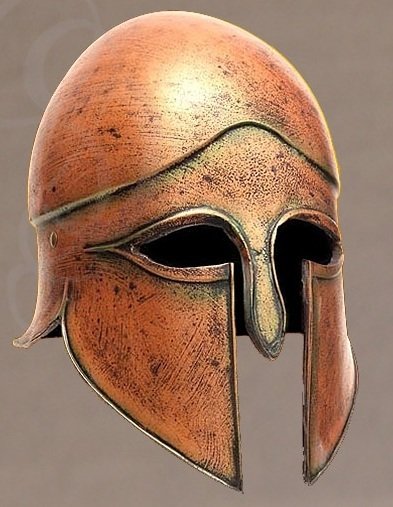
The helm that launched a thousand movies.
Corinthian Helmet - 8th century B.C.E.: Yeah, we loved the movie 300. Leonidas and his happy few, taking on the entire Persian army (and some really strange creatures that apparently the Persians brought out for battles). The Spartan helmet worn by Leonidas and his crew is a creative design based on the Greek Hoplite helmet(otherwise known as the Corinthian helmet). Another Corinthian style helmet was the Troy helmet, used in the Troy movie. The Hoplites were among the most heavily armored soldiers in history. Their helmets covered most of their face, with huge cheekplates and a long nasal that left very of the face exposed. A tall horsehair crest (front to back, or from temple to temple) was often added to the helmet to indicate rank or unit, or just to make these helmets that much more bad-ass. Variations of the Corinthian helmet were seen in Greece and Italy for hundreds of years.
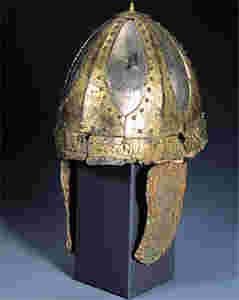
Spangenhelmens ara gooda, ya?
Spangenhelm, 6th to 10th century: That's the 500s to the 900s, for those of you chronologically challenged. Spangenhelm is German for "Please buy Volkswagens." These types of helmets were usually a bit conical (pointy toward the top). These are the helmets you typically see in movies when the time period is somewhere between the fall of the Roman Empire and the start of the Norman conquest. They usually have cheek pieces and can be highly decorated, sometimes have face masks, and occasionally have chain mail aventails that protect the back of the neck. Variations of this type of helmet go all the way back to the first century A.D., but only a very few are capable of this sort of time-travel. Yeah, not funny. But, seriously, this is an ancient type of helmet. Some Viking helmets came down from this family tree. And the Sutton Hoo helmet, although it has more in common with a Roman Cavalry helmet, is "spangenhelmish." Which, in German, means, "Pretty please buy Volkswagons."
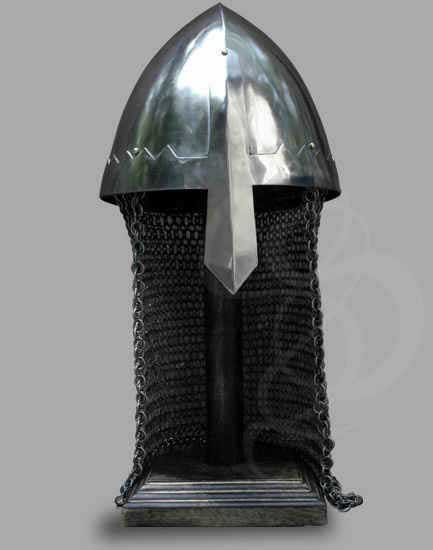
The Norman Mailer Helm
Nasal Helm/Norman Helm, 11th to 13th century: Yes, I know that nasal helms have been around since the Byzantine Empire, but the height of their popularity in modern culture is the 11th-12th centuries. These helmets gradually replaced the spangenhelms. They're the ones you see soldiers wearing in the Robin Hood movies. The ones worn by the Normans who fought at the Battle of Hastings under William the Conqueror. A lot of Viking helmets are actually similar in design to Norman helmets (although probably having more in common with spangenhelms). Nasal helms are usually conical, and they make your voice sound really pinched, which is why they call them nasal helms. Okay, not true. But kinda funny? Maybe? They're called nasal helms because of a piece of metal that extends over the nose, preventing a Tyrion Lannister sort of nose-chopping-off injury. (For those who actually read the books.)
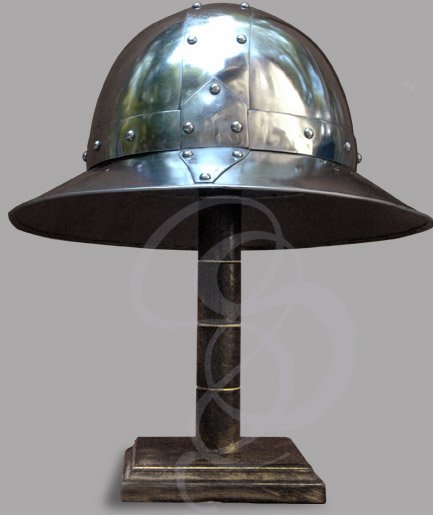
The Iron Hat.
Kettle Helm, 11th century: This is another example of a helmet that lasted for much, much longer than one century. The 11th century is when the helmet was most popular, but variations of this type of helm have existed all the way into World War II. are also known as "chapel de fer," which, in French, means either a church made from the hair of animals, or an iron hat. Many variations of these helmets exist, but all have wide metal brims, and most do not have any sort of face protection. Contrary to popular belief, they don't get their name from soldiers cooking their meals in these helmets. The name supposedly stems from the shape, which resembles a cooking pot. And, really, heating metal over and over again is probably not something you want to do if your brain depends on the strength of that metal.
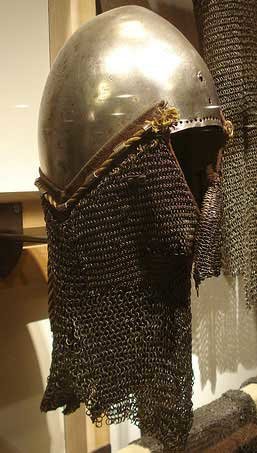
Cevelliere
Cervelliere, 12-14th centuries: The cervelliere wasn't truly a helmet. It was a steel beanie worn on top of the head, usually over a chain mail coif. Excellent for protecting the top of the head from sword blades and pigeon crap. This, again, is something that was used for much longer than I have designated, but instead of being worn as head protection, it was worn over a chain coif and under a great helm, as extra protection.
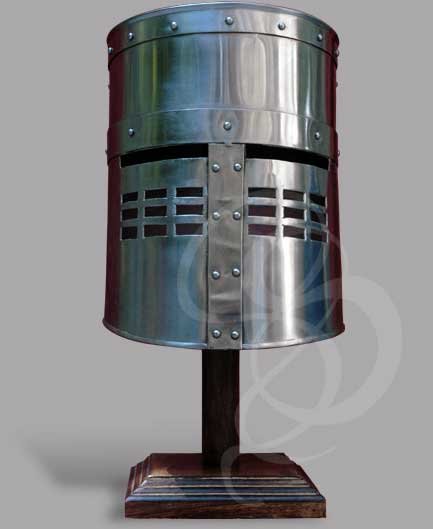
The Greatest Helm Ever.
The Great Helm, 12th to 14th centuries: How can you not love a helmet that has "great" in the name? And these helmets are, without doubt, great. They should be called the Awesome Helm. There are other names for this sort of helmet: pot helm (popular in Colorado), bucket helm, awesome helm, and barrel helm. (See what I did there? If I say it enough, it will become true). Great helms cover the entire head. A great big cylinder of steel, with eye slits and (often) perforations near the mouth for breathing pleasure. These helms were originally flat-topped, which looked cool, but provided a lovely target for war hammers and poleax spikes. The evolved version was called the Raichu Helm, and could shoot huge bolts of lightning and... wait... no... I'm thinking of something else. The evolved form was actually still called a great helm, but was curved to deflect blows. Great helms were typically worn over a padded hood, and sometimes a chain coif and cervelliere (and if you have to ask what a cerverlliere is, you have failed the Strongblade Helmet School final exam)(Hint: see above). Crusader Helmets (like the ones worn by knights in the first few Crusades) were examples of great helms.
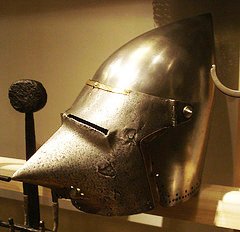
In it's hideous glory.
Hounskulls, 14th century: We go from my favorite helm, to my least favorite. Although they provided effective protection for the face and better ventilation than the awesome helm (I'm still trying...), they were not the most artistic of helmets. Hounskulls were basically tall bascinets with beaked visors that could be raised when not in combat. Slits in the visor allowed for vision, and tons of little holes around the beak provided air. But no amount of perforations can help bad taste.
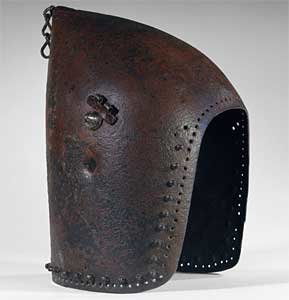
Where does the baby go?.
Bascinet, 14th century: I probably should have mentioned this before the hounskull. Bascinets were a little more common, and it was a common practice for knights to put their babies to sleep in them when it was bedtime. Hmm. I might be mixing that last part up. Anyway, bascinet helms were typically open-faced. You could attach a pig-face visor to them, which terrified the housemaids and made the helmet a hounskull (see above). Bascinets usually were worn with chain mail aventails that protected the back of the neck and the throat. This was replaced later by a steel bevor to protect the neck/chin.
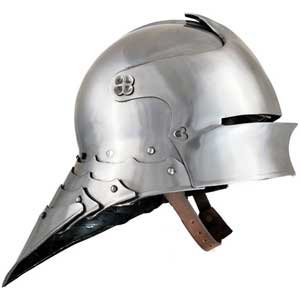
Doesn't get much Cooler.
Sallet, 15th century: Ah! Another one of my favorites. This is the helmet worn by the Laraytian Standard soldiers in the The Beast of Maug Maurai trilogy. The sallet was a half-helm, really. A bascinet with a long, curved brim at the back to protect the neck and shoulders. Add the half-visor that protected the top half of the face, and you have a work of art. These helmets were sometimes worn with bevors that swept upward to cover the mouth, chin and throat (parts left open by the sallet). Some version had the visor integrated. Others had swiveling visors. And some had ad-visors, tiny people that would sit on the brim and talk to you about your best options in combat. No. Wait. I think that last one was a dream I had. Never mind. This helmet was enormously popular in Germany and Italy.
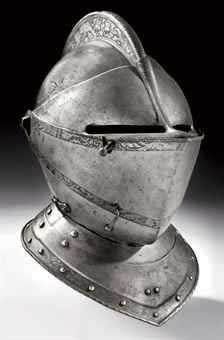
Yeah, helmets are cool.
Armet/close helm, 15th century: Yeah, a few medieval scholars just groaned when they saw both of these helmets in the same category. You see, these helmets are often lumped together, even though they are vastly different from one another. Or not. The only real difference is that armets have swiveling cheek plates, while close helms had bevors that pivoted upward and away from the face with the visor. Close helms are typically identified with the 16th and 17th century, as well. So there are grounds for historical grumbling when the two helmets are lumped together. Both helmets fully enclose the face, and are more fitted to the wearer's head than many of the other helms from history. Both are also really damned cool. Fine pieces of medieval helmetry.
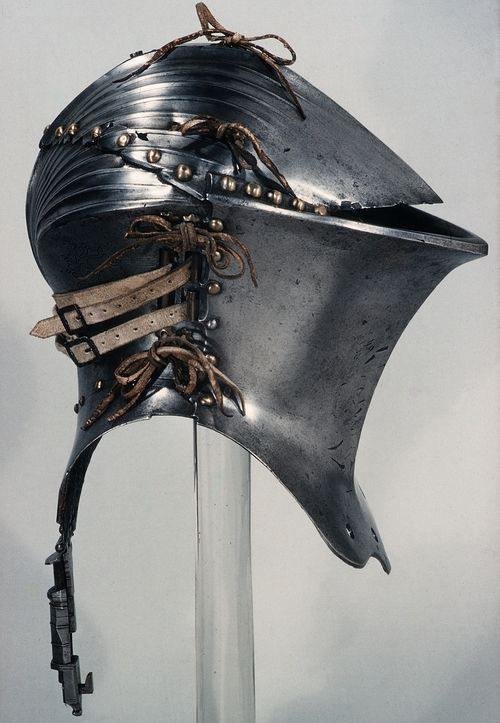
Not much use except for jousting.
Frog Mouthed Helmet, 15th Century: For a really cool looking helmet, this has a seriously dorky name. They could have gone with arch-helm, or razor-helm, or awesome helm (if that wasn't already taken, right? Right?). It was called a frog-mouth helm because the lower brim juts out like the open mouth of a frog. But, seriously? Sigh. Anyway, this type of helm was used almost exclusively for jousting. The narrow visor and the jutting lower brim protected the jouster's eyes. These helms included an elaborate web of straps inside that kept the steel from actually touching the knight's head. This prevented the transfer of energy from lance to skull. Maybe the National Football League should look into this, eh?
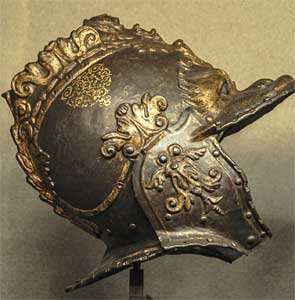
Often heavily engraved.
Burgonet, 16th century: Burgonets were similar to armets, but they had a characteristic ridge that along the top of the head, starting at the forehead and curling back like a crest. These helmets did not typically have face protection, but had long cheek pieces and a long, curved brim at the front. Sometimes something called a falling buffe was added to protect the face. A falling buffe was a piece of metal that used to be shiny but, over time, became dull. Um. Yeah, not really. Okay, a falling buffe was a visor/bevor that was made from several metal plates and could be attached to the burgonet. Many ceremonial types of these helmets were made, often in Italy. And there are some *fine* examples of these works of arts. Poke around the internet. You won't be disappointed.
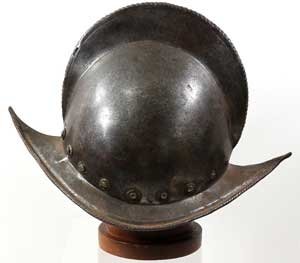
Paging John Smith...
Morion, 16th-17th centuries: The Morion is best known as the conquistador helm. You know, the one the soldiers wore in Disney's Pocahontas. These types of helmets were similar in a "Yeah, I'm a Kennedy, too" sort of way to Burgonets. They both have the long, curving crest looping back from the forehead, although the morion crest is often slightly larger. And they both have brims along the front (and sometimes the back). Morions can have cheek pieces, but typically do not. They rarely had any type of face protection. The fantasy novel I am currently working on features these helmets. More on that at a later date...
Okay, that's kind of like an entire book about helmets.